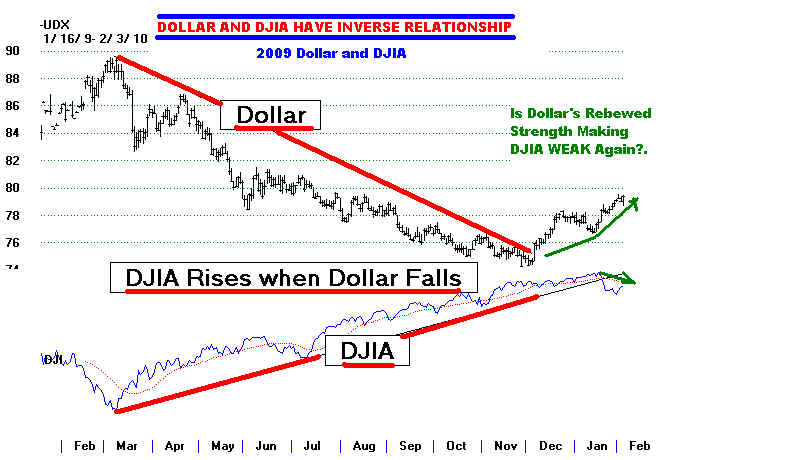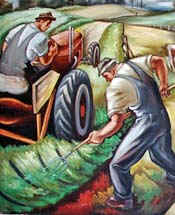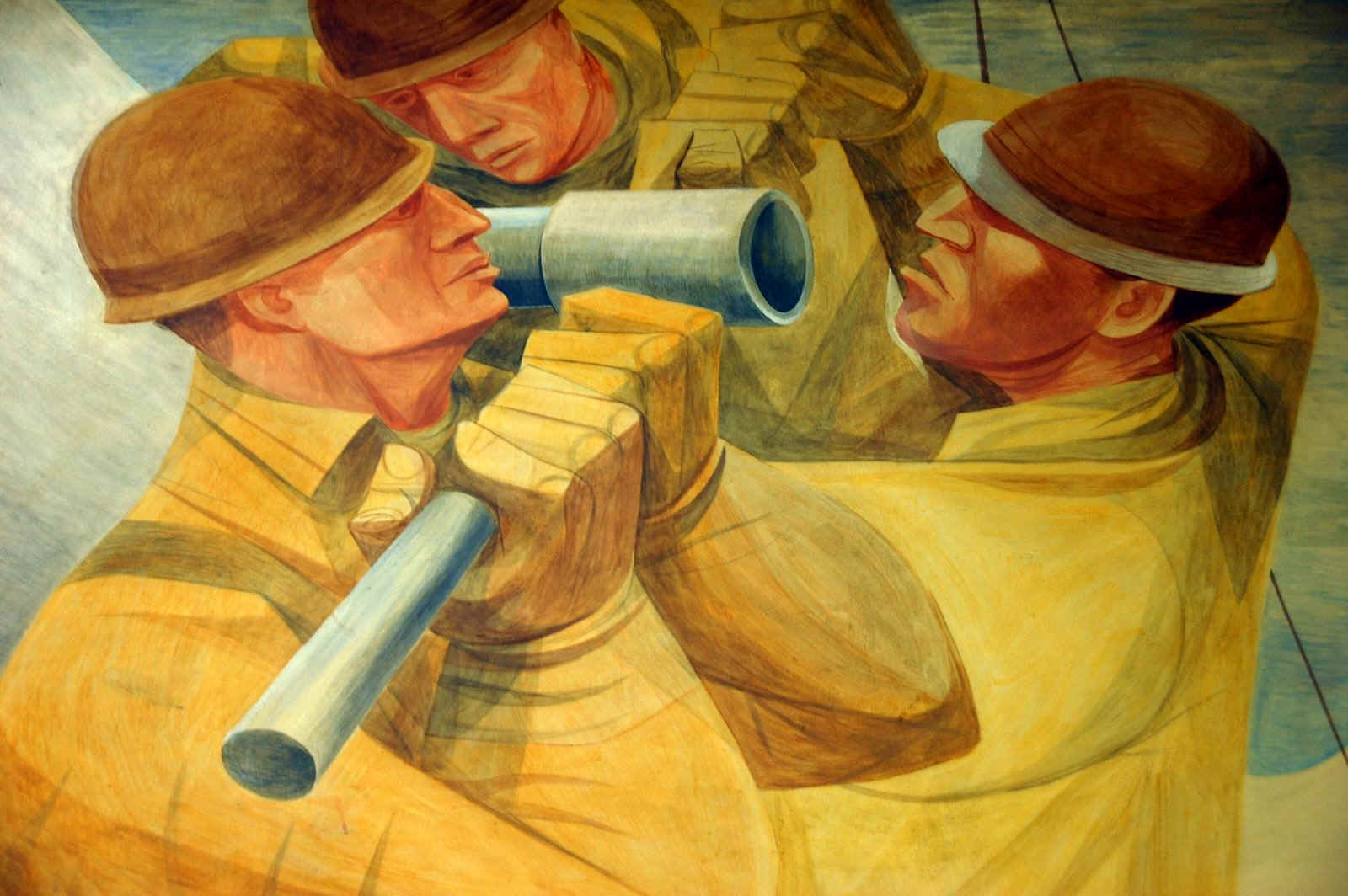 TigerSoft News Service 2/4/2010
TigerSoft News Service 2/4/2010
Will Obama Create Another 1937-Like CRASH?
If Obama Keeps Listening To Self-Serving Bankers,
The Risks of A Severe Decline Are VERY HIGH.
The Lessons of The 1937 CRASH!
Obama, Read Some FDR History!
by William Schmidt, Ph.D.
Author of TigerSoft's Insider Watch Software
http://www.tigersoft.com/--3--/Explanation/index.html
http://www.tigersoft.com/--3--/index.html
Peerless Stock market Timing: 1915-2010
http://www.tigersoft.com/Samples/Charts/index.html
www.tigersoft.com PO Box 9491 - San Diego, CA 92169 - 858-273-5900 - william_schmidt @hotmail.com

Obama Should Read A Little FDR History.
Will Obama Make The Same Mistake That FDR did in 1937?
Sure, I know, Obama now says he is willing to have a fight with banks. He says that he
wants a new tax on frequent trading and wants to ban banks from speculatively trading
for their own account. But really, what are the chances of getting a 2/3 vote out of
the Senate? And if Obama behaves as he did with health care, he won't do much
to twist any arms to get whatever bill the conservative Senate Finance Committee
does come up with. So, the market's weakness today - the DJI was down 268 or 2.61% -
may really be due to other reasons, the primary one being that the economy is failing
to continue to recover, because Obama's fiscal policies are mistakenly deflationary,
at a time when inflation and vastly more government job creation is the only answer.
The lessons of 1937 make that clear. Consumers are tapped out. Banks are not loaning
to businesses. The only way the economy can match the market's snappy recovery,
so that a snap-back in the market does not occur, is if the government coninues to
spend and create a million new jobs for all those lost in the last year. Obama has
just made matterns much worse, by saying he will be cutting back government
spending. That foolish pandering to ignorance may be deadly for the stock market.
Sadly, if Obama had done more reading of US economic history, specifically 1937-1938,
| he would not be making this mistake.
A year ago, Edward Harrison of Roubini Global Associates offered a keen insight into
why Obama would fail America in the area of economic leadership. His natural caution
would give a job-creating stimulus a bad name. Being relatively ignorant of economics
himself, instead of explaining and selling the rationale for Keynesian deficit spending,
his early support for a stimulus would be inadequate, passive and unpersuasive. In time,
he would need a much larger fiscal stimulus. But by the time he realizes his mistake,
his first too-cautious measures will have failed and he will be seen as inconsistent
and his leadership jerky and unsure.
"Bloomberg News is reporting that U.S. state governments will begin cutting spending
in order to meet budgetary constraints as the Obama administration’s transfers
to local government will not be enough to offset reveue shortfalls. These cuts will
offset any federal stimulus, endering the $787 stimulus package recently enacted less
effective,...(So,) the Obama administration is caught in some sort of muddle, trying to
fudge between the calls for fiscal discipline from conservatives and the calls for
stimulus from liberals. ...Obama’s nature to lead by consensus, and he has looked for
an inclusive political and economic strategy since he came to office. However...this
middle path ...will leave no one satisfied. Moreover, taking this middle path on the
economic front — some stimulus but not massive stimulus, some tax cuts but also
some increased spending, increased spending now but tax increases or budget cuts
in a few years - is the worst of all outcomes; the economy will not gain enough traction
to get the desired ‘jump-start’... (Thus, the stimulus will ultimately be seen as ineffective.
(Later, if the Obama Administration later attempts to return to Congress for more of
the same after a failed stimulus bill, it will find a more skeptical response."
WHAT
A STUDY OF 1937-1938 WOULD TEACH OBAMA
In early 1937, FDR wanted to gain back Congressional support from
Southern
Democrats who demanded a balanced budget, So, instead of
listening to the
economist Keynes who advocated deliberate deficit government spending
to
create jobs while the private sector was hoarding money (like banks do
now),
he listened to his Treasury Secretary (Morgenthau) and again publicly
declared for
a balanced budget, just as he had in his 1932 Presidential
Campaign.
Treasury Secretary Morgenthau convinced FDR that private investors
considered
federal deficits dangerously inflationary (remembering Weimar Germany)
and the
eventual taxation they would require would be too unsettling for
private investors
to have sufficient confidence to put their money at risk.
Inflation was only 3.6% in 1937. Despite this, FDR fully accepted
the premise
that private capital was the primary source of jobs in the US, despite
its utter failure
in the 1930s. He acquiesced in Morgenthau's notion that the stock
market
had dangerously begun to bubble because it had almost quadrupled
between
FDR's Innaugration and March 1937. He warned that another 1929
Collapse
might happen unless fiscal austerity was shown by the Government and
the
"speculative bubble" of 1933-1937 was pierced. As it
turned our, this was terrible advise.
WPA Murals in Cincinnati and
Cleveland. Were They A BoonDoggle?
Hardly. For 73 Years, travellers have stopped and looked and admired them.
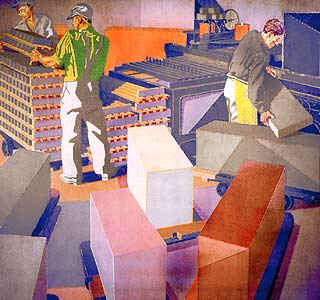
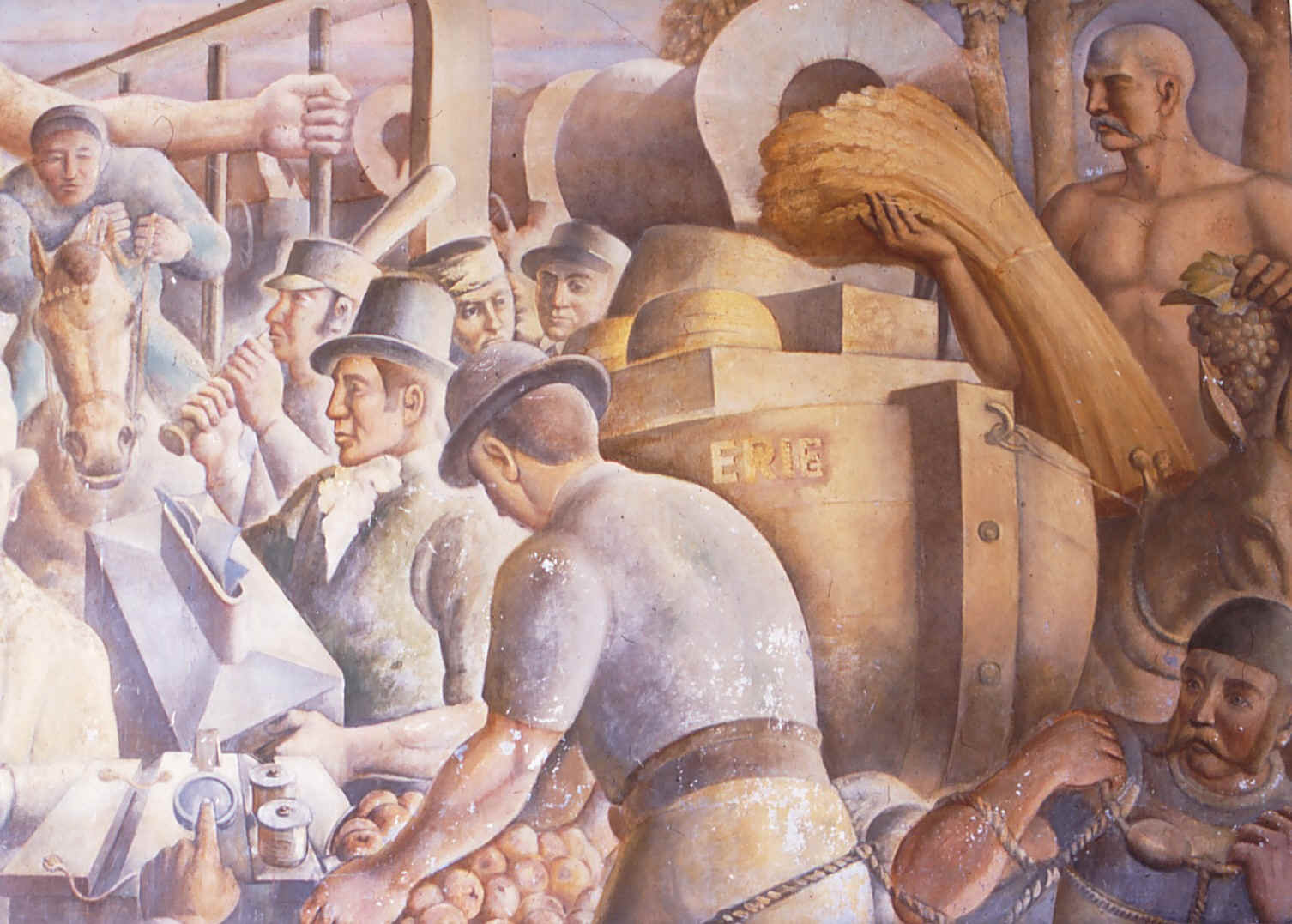
FDR's 1937 Budget did sharply cut back spending programs. WPA artists
no longer
created beautiful murals and photographers no longer recorded the lives
of
Southern working men. Wilderness camps for young men to shape new
public parks
and fight forest fires were all cut back. Soon, there was another
sharp jump in
unemployment, a drop in business confidence and a disastrous market
decline.
The economy disastrously fell over a new cliff. Unemployment
jumped from 14.3%
to 19.0% in 1938.
Manufacturing lost 3 years of gains and sropped back to 1934 levels.
But FDR was was not an ideologue. In 1938, FDR saw his mistake
and began spending
programs again without heeding short-term budget constraints.
He listenened to Keynes
not his Treasury Secretary or conservative Democrats. The
market roared back
despite bleak international news. In February 1938,
Congress passed a new AAA bill
which authorized crop loans, crop insurance against natural disasters,
and gave large
subsidies to farmers who cut back production. On April 2, 1938,
Roosevelt sent a massive
new spending program to Congress. $3.75 billion was then split
between PWA, WPA,
and various relief agencies. Other
appropriations raised the total to $5 billion of new
government spending early in 1938. The economy then turned around and
recovered.
( Source: http://en.wikipedia.org/wiki/Recession_of_1937%E2%80%931938
)
"In the fall of 1937, an economic recession struck the American economy.
Although not as severe as a depression, the recession was worsened by
Roosevelt’s unwillingness to spend money, as the government at
that time was already millions of dollars in debt. The economic
downturn caused a rift within the Roosevelt Administration; some of FDR’s advisors,
like his Secretary of the Treasury, Henry Morgenthau, Jr.,
urged
him to balance the budget and abandon the course of great government expenditure as had
been taken earlier,
while another group, headed by Harry Hopkins of the WPA, urged Roosevelt to unbalance the
budget by
running a deficit and increasing government spending. Although
the former group believed that balancing
the budget would increase spending in the private sector, the latter faction was backed up
by the already- -proven-successful policies of John Maynard Keynes. Keynes,
who attributed the 1937 recession to
the American economy’s lack of preparation for an increase in investment (as public
relief programs helped
more Americans get on their feet again, investment and spending altogether increased),
had, up to that point,
theorized on the effictiveness of government spending in
reversing a depression and making up for the lack of
investment in the private sector of business .... Keynes, who
also believed that copious government expenditure would cause a re-stimulation of the
economy, had a large impact on both Roosevelt and the
advisors who helped coach him out of the recession of 1937, and although FDR was at first
reluctant to spend
more money in order to rebound from the events of 1937, he eventually recognized the need
for more
government expenditure, as called for by Keynes. Thus, in March
1938, Roosevelt announced a plan for a
new federal outlay agenda, which, within the course of just months, would help to
significantly improve
America’s economic situation..." ( Source:
http://harwich.edu/depts/history/HHJ/Clark.html
)
The stock
market felll 40% in the Fall of 1937. This was the second biggest six-month
decline in stock market history. The decline took place in
only 14 weeks. Keynesians
say FDR's policy choices caused this second Depression and
stalled the 1930s' recovery.
Of course, gathering war clouds in Europe and Asia also
worked to unsettle the stock
market. Asian markets for American goods were badly
disrupted when China was
brutally attacked by Japan on July 10, 1937. This quickly
led to Japan's attack on
Shanghai in August 1937and continual warfare until l945. In
Europe, Hitler was
militarily
preparing for the Anschluss Österreichs (the German
annexation of Austria)
and then the German take-over of Czechoslovakia in March 1938 and
October 1938, respectively.
Peerless Sell S9s Mark Tops in 1937
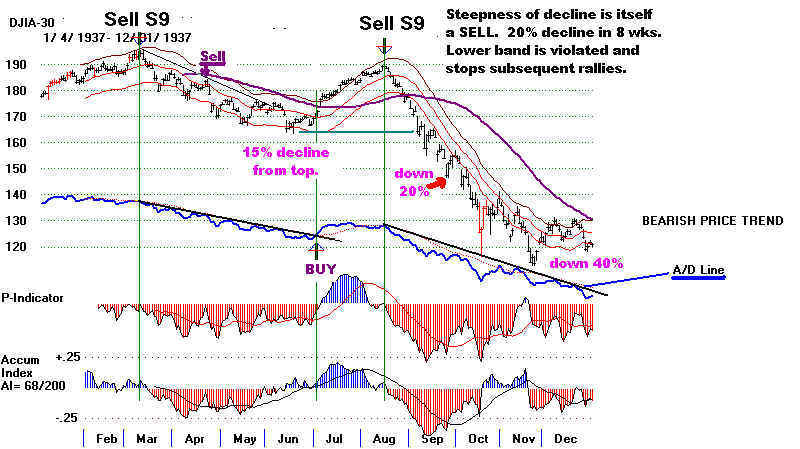
While a
world war is not on the horizon, the Obama Administration says the
chances for
an attack by Al Qieda in the US are high. But this is not where the
eerie
parallels between now and 1937 are.
OBAMA
IS MAKING THE SAME MISTAKES FDR DID IN 1937
The danger
centers on Obama's shifting away from a progressive jobs-creation
agenda to
placing higher priority in fighting wasteful spending and a "pay-as-you-go
fiscal
policy. Obama seems to believe he must be still more conciliatory to
his party's
conservatives, especially the fiscal Conservatives in his party. Liberals
and
Progressives he feels he can disregard. So, despite criticisms from liberals like
Nobel
prize-winning Krugman, Obama is now talking about a spending freeze
on
non-military spending. This is dangerous orthodox budget balancing in the middle
of a near
Depression. He is again accepting Bankers' ideology as omniscient
and not
self-serving. His Wall Street advisors still rule him. He is too inexperienced
to see how
badly he is being served. In college, he should have studied some
American or
European history somewhere along the line. European governments
everywhere,
from 1929 t0 1932, made the Depression worse by following this approach.
Hoover was
no better in the US.
BANKERS'
SELF-SERVING NONSENSE
I wrote my
dissertation at Columbia about the FINANCIAL ORTHODOXY approach's
failure in
England's "locust years, 1919-1940. The English economist. JM Keynes,
had warned
that this fiscal ideology, laudable as it sounds, was suitable only when
private
economies were strong and jobs plentiful. Balancing the budget, at all costs,
and a
"make- the-pips's squeak" cutting back of government expenditures was
proven
wholly inadeuate and dangerous in the 1930s, though is was the othodoxy
and view
put forth by bankers worldwide, the Bank of England, Chancellors of the
Exchequer.
Chancellors, I showed in my dissertation, also wanted to limit the chances of any
spending minister
becoming too popular and thereby challenging the Chancellor's
normally
pre-ordained rise to the Premiership. It was this orthodox balance-the-budget,
cut government
spending and make the Dollar strong that was always, ALWAYS,
the view
set forth and advocated by US Treasury Secretaries to Presidents,
Republicans
or Democrats. "Defend the pound."Or "Defend the
Dollar" in the US.
Fear
inflation. Government is a barren whore. Only private-for-profit jobs are
real.
Maintain
the Pound (or Dollar) as the most important international currency. Secure
London or
New York as then center of international finance.
For big
bankers in New York and London, this orthodioxy was and is clearly
a
self-serving set of arguments. It is propaganda to defend the richest class
and deny others a
chance to rival them. Among the hidden agendas, not the least
imprtant, was
that bankers wanted to make their debtors pay back their loans in
deflated (worth
more) dollars.
Considering how
Obama has, despite his public rhetoric, given bankers hundreds
of billions of
taxpayers' dollars in TARP, always allowed the outlandish bonuses
to their
executives and then has [ermitted to stand the sixty-five billion more in AIG
counter-party
payments which Obama's Treasury Secretary-To-Be tried for months
to conceal from
the public, so noxious was the deal, So, I am not surpised now,
in the slightest
that Obama is completely failing the American people again as he
promotes and
falsely legitimizes the bankers' self-serving, budget-balancing orthodoxy
The obvious
problem with this approach now and in the 1930s was that economic
fear was
too high. Confidence in main steet was too low. Private banks and investors
hoarded or
speculated their money and savings. They did not put anywhere near
adequate amounts
money to work in businesses that would create jobs. And so
high umemployment
persisted. That bankers never questioned themselves and
their smugly
self-serving orthodoxy suggests they are not worthy of any government
money. A
national. goverment-owned bank could not help but improve the economy
at far less cost.
"Greedism" must be ended.
That defending
the Dollar as bankers want to an extreme is dangeorus for the
economy AND the
US Stock Market. See the inverse relationship between the
Dollar and the
Stock Market in 2008 and 2009. how the stock market has gone d
----- DOLLAR'S 2008 RISE ACCOMPANIED BY
US STOCK MARKET COLLAPSE-----
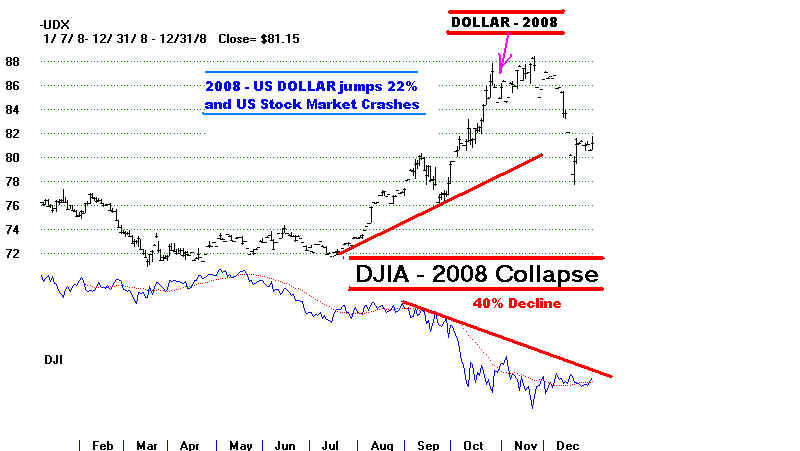
----- DOLLAR'S 2009
DECLINE ACCOMPANIED BY US STOCK MARKET RALLY-----
